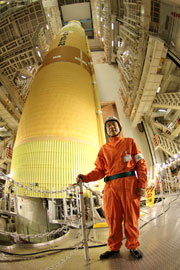Here are messages from Project Managers.
Tomihisa Nakamura / H-IIB Project Manager (Launch Vehicle Director)

The H-IIB Launch Vehicle (H-IIB) is the largest rocket in Japan, which was developed mainly for launching the H-II Transfer Vehicle KOUNOTORI (HTV), a cargo transfer vehicle to the International Space station (ISS), and other large payloads. For the development of the H-IIB , we have capitalized on accumulated technologies through our experiences with the H-IIA Launch Vehicles. In September 2009, the first H-IIB (a test flight) was launched with the KOUNOTORI1, a demonstration flight of the HTV, onboard. This test flight was launched on schedule, and it was the first time for Japan to launch the first flight of a major launch vehicle series without any delay. The launch was very successful as the orbit injection was very accurate, thus it verified that this vehicle had more than the required launch capability. Consequently, we believe that we have demonstrated the maturity of our launch vehicle technology domestically and internationally. The launch this time is the second H-IIB flight , and we have further improved the reliability of our rocket including improving a payload fairing (reinforcing the separation mechanism) for the payload this time, the KOUNOTORI2.
H-IIB is the sixth launch vehicle since our first major launch vehicle N-I, and this will mark the 51st launch. Furthermore, it is the 20th launch for theH-IIA and H-IIB launch vehicles, thus it is a landmark launch. We now have less than two months before launch, and all of us are pulling ourselves together, and bracing ourselves for a successful launch. Your support is very much appreciated as it was for the test flight.
H-IIB is the sixth launch vehicle since our first major launch vehicle N-I, and this will mark the 51st launch. Furthermore, it is the 20th launch for the
[December 22, 2010 Updated]
Yoshihiko Torano / HTV Project Manager

The previous mission, the first H-II Transfer Vehicle (HTV Demonstration Flight,) was almost 100 percent successful. Therefore, many of you may think that we are more composed this time. Actually, I think we are more strained than the last time because I believe that the success of the second mission is often believed to be a matter of course, although expectations for the first flight are usually lower (something like 98 percent) as the first one tends to fail. I feel that expectations this time are probably 100 percent. If, by any chance, we fail this time, we will be criticized.
Now, even under the pressure of budget restrictions, no failure or excuse is acceptable.
The biggest concern for me is that this kind of situation may pose a burden on the minds of the engineers and operators. The best environment where human beings can exhibit their utmost ability is in relaxed conditions with a comfortable level of tension against carelessness. I hope that all personnel involved in the launch, tracking and controlling of the second mission will work in a positive and relaxed environment.
In addition, we decided to conduct a special inspection, thus we need to pour extra energy into that. We will check the KOUNOTORI2 with fresh eyes to find any problems and fix them if necessary in order to achieve consecutive successful launches.
Now, even under the pressure of budget restrictions, no failure or excuse is acceptable.
The biggest concern for me is that this kind of situation may pose a burden on the minds of the engineers and operators. The best environment where human beings can exhibit their utmost ability is in relaxed conditions with a comfortable level of tension against carelessness. I hope that all personnel involved in the launch, tracking and controlling of the second mission will work in a positive and relaxed environment.
In addition, we decided to conduct a special inspection, thus we need to pour extra energy into that. We will check the KOUNOTORI2 with fresh eyes to find any problems and fix them if necessary in order to achieve consecutive successful launches.
[December 22, 2010 Updated]
